Jonathan Zamora
Biomedical image analysis competitions: The state of current participation practice
Dec 16, 2022Abstract:The number of international benchmarking competitions is steadily increasing in various fields of machine learning (ML) research and practice. So far, however, little is known about the common practice as well as bottlenecks faced by the community in tackling the research questions posed. To shed light on the status quo of algorithm development in the specific field of biomedical imaging analysis, we designed an international survey that was issued to all participants of challenges conducted in conjunction with the IEEE ISBI 2021 and MICCAI 2021 conferences (80 competitions in total). The survey covered participants' expertise and working environments, their chosen strategies, as well as algorithm characteristics. A median of 72% challenge participants took part in the survey. According to our results, knowledge exchange was the primary incentive (70%) for participation, while the reception of prize money played only a minor role (16%). While a median of 80 working hours was spent on method development, a large portion of participants stated that they did not have enough time for method development (32%). 25% perceived the infrastructure to be a bottleneck. Overall, 94% of all solutions were deep learning-based. Of these, 84% were based on standard architectures. 43% of the respondents reported that the data samples (e.g., images) were too large to be processed at once. This was most commonly addressed by patch-based training (69%), downsampling (37%), and solving 3D analysis tasks as a series of 2D tasks. K-fold cross-validation on the training set was performed by only 37% of the participants and only 50% of the participants performed ensembling based on multiple identical models (61%) or heterogeneous models (39%). 48% of the respondents applied postprocessing steps.
Graph Inverse Reinforcement Learning from Diverse Videos
Aug 01, 2022
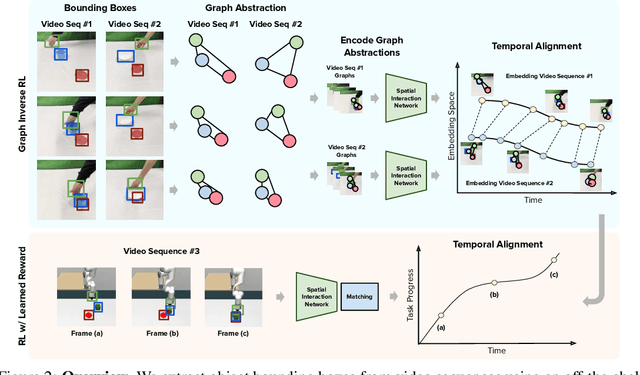

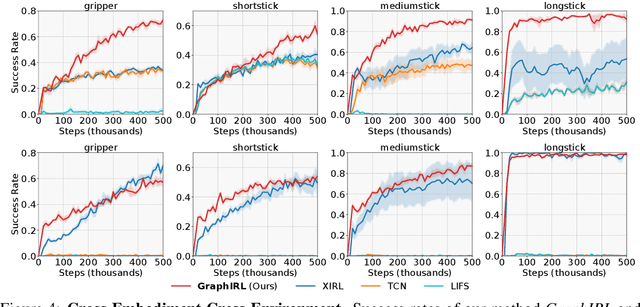
Abstract:Research on Inverse Reinforcement Learning (IRL) from third-person videos has shown encouraging results on removing the need for manual reward design for robotic tasks. However, most prior works are still limited by training from a relatively restricted domain of videos. In this paper, we argue that the true potential of third-person IRL lies in increasing the diversity of videos for better scaling. To learn a reward function from diverse videos, we propose to perform graph abstraction on the videos followed by temporal matching in the graph space to measure the task progress. Our insight is that a task can be described by entity interactions that form a graph, and this graph abstraction can help remove irrelevant information such as textures, resulting in more robust reward functions. We evaluate our approach, GraphIRL, on cross-embodiment learning in X-MAGICAL and learning from human demonstrations for real-robot manipulation. We show significant improvements in robustness to diverse video demonstrations over previous approaches, and even achieve better results than manual reward design on a real robot pushing task. Videos are available at https://sateeshkumar21.github.io/GraphIRL .
Contextualized Scene Imagination for Generative Commonsense Reasoning
Dec 16, 2021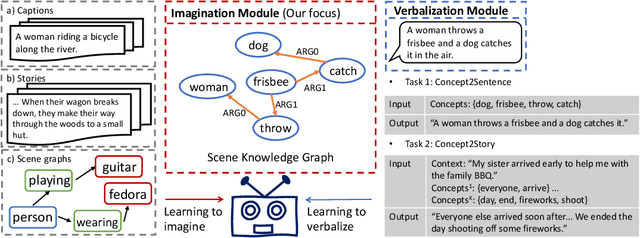
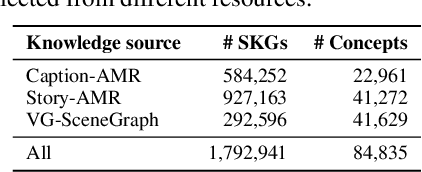

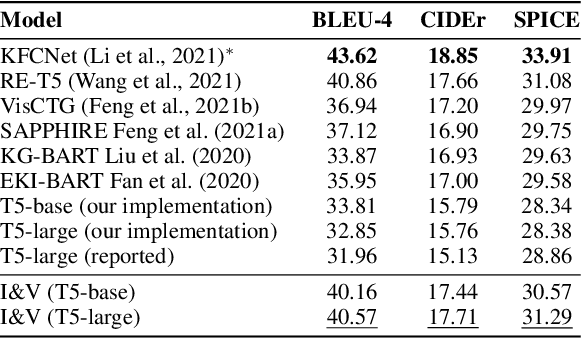
Abstract:Humans use natural language to compose common concepts from their environment into plausible, day-to-day scene descriptions. However, such generative commonsense reasoning (GCSR) skills are lacking in state-of-the-art text generation methods. Descriptive sentences about arbitrary concepts generated by neural text generation models (e.g., pre-trained text-to-text Transformers) are often grammatically fluent but may not correspond to human common sense, largely due to their lack of mechanisms to capture concept relations, to identify implicit concepts, and to perform generalizable reasoning about unseen concept compositions. In this paper, we propose an Imagine-and-Verbalize (I&V) method, which learns to imagine a relational scene knowledge graph (SKG) with relations between the input concepts, and leverage the SKG as a constraint when generating a plausible scene description. We collect and harmonize a set of knowledge resources from different domains and modalities, providing a rich auxiliary supervision signal for I&V. The experiments demonstrate the effectiveness of I&V in improving language models on both concept-to-sentence and concept-to-story generation tasks, while enabling the model to learn well from fewer task examples and generate SKGs that make common sense to human annotators.
 Add to Chrome
Add to Chrome Add to Firefox
Add to Firefox Add to Edge
Add to Edge